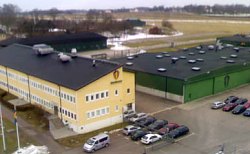
| - |

From 2002 to the end of 2012, the company delivered 100 cars in total.
However, Koenigsegg has yet to prove its sustainability beyond the CC series. Quandt, the 4-seat electric supercar displayed in 2009 Geneva motor show, might be the answer.
Koenigsegg locates in an ex-air force base at Angelholm of Southern Sweden. Its factory was converted from hangar, not the kind of sophisticated facilities you might expect for the supercar. Anyway, the runway allows it to perform high-speed testing, and the rich customers can easily arrive by helicopters.
 CCR (2005)
CCR (2005)After 8 years of development, testing and homologation, the first customer car was finally delivered in 2002. In the first 2-3 years, Koenigsegg built only 6 cars as it lacked the reputation of established supercar makers. However, it kept improving the car no matter in performance or quality. When the 806-horsepower CCR lapped Nardo test track at 241 mph in 2005, breaking the long-standing speed record of McLaren F1, orders started flowing in. In the next two years, Koenigsegg built another 20 cars. By mid-2008, it had already delivered 60 cars to customers. The latest cars were sold at 1 million Euro each.
Together with Pagani, Koenigsegg was the only new supercar maker successfully established a sustainable business in the recent 20-30 years.